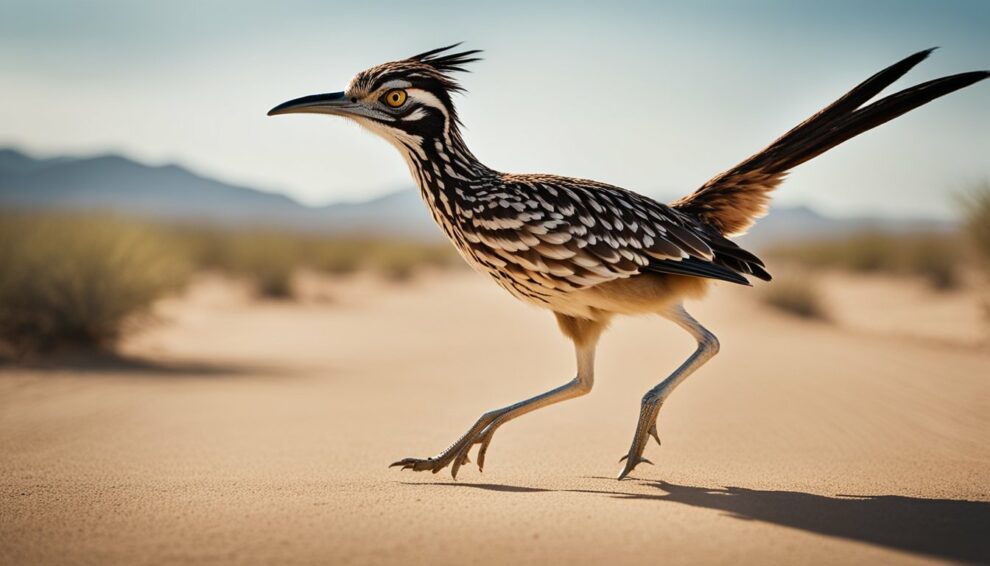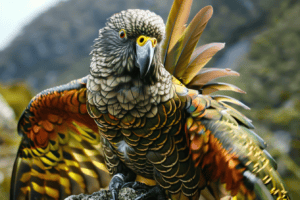The roadrunner is a true marvel of desert survival, equipped with a suite of adaptations that make it a master of arid conditions.
These birds, iconic for their agility and speed, do much more than outpace their predators and prey.
In the sweltering desert climate, water can be as elusive as a mirage, and food—a buffet or a famine.
Yet, the roadrunner thrives where many creatures would falter.
This bird’s body is a playground of biological ingenuity, turning obstacles into opportunities.

Have you ever wondered how a roadrunner can sprint across the desert without a water bottle?
Unlike humans, roadrunners obtain moisture from their diet, which is vast and varied.
They feast on insects, scorpions, lizards, and small mammals, each bite delivering crucial hydration.
But winter can pose a challenge, as critter cuisine becomes scarce. The roadrunner pivots gracefully, dining on plants to fill the gap.
And in a remarkable twist, these birds recycle water internally, reabsorbing it from their waste before it’s too late.
When the desert turns up the heat, the roadrunner doesn’t throw in the towel.
Its body is tailor-made for high temperatures, with feathers that blend into the parched landscape and a unique cooling system that could make any engineer jealous.
As the sun beats down, the roadrunner basks in its own resilience, a living testament to the wonders of adaptation.
So, if you find yourself under the wide, blue desert sky, keep an eye out for the streak of feathers that’s beating the odds with every step.
Physical Characteristics and Adaptive Traits

The roadrunner is an expert at living in the tough desert environment.
Let’s take a closer look at what makes these birds so special in terms of their physical makeup and their amazing survival skills.
Fantastic Feathers and Feet
Roadrunners (Geococcyx californianus) are medium-sized birds that you might see zooming across the desert landscape.
They typically measure about two feet from beak to tail-tip, and they have a pretty nifty set of feathers.
Their feathers are a mix of browns, whites, and blacks, which helps them blend into the desert surroundings—this is their natural camouflage.
When thinking about staying cool, it’s their feathers that play a big role.
They can lift these feathers to create shade and manage their body temperature, as excessive heat can really drain their energy.
Along with their feathers, their feet are equally interesting.
They have strong legs and unique zygodactyl feet — that’s two toes facing forward and two backward.
These special feet give them a strong grip and the ability to make swift turns. Have you ever wondered how they deal with the desert’s hot ground?
Well, their feet are tough enough to handle the heat, and they don’t mind at all!
Water Wise Wonders
If you ever wondered how roadrunners can be so active in a place where water is scarce, then you’re about to find out their secret.
They have developed incredible adaptations to conserve water.
Their metabolism works in such a way that it minimizes water loss; even when they breathe, they lose less water than you’d expect.
Roadrunners obtain water from the food they eat and have also developed a really smart salt management system.
They have special salt glands near their eyes, and what they do is actually quite smart — these glands help excrete excess salt without losing much water.
This way, they make sure they’re not too thirsty and can keep darting about even when it’s scorching hot outside.
Their long eyelashes are more than just about looking good; they actually protect their eyes from the harsh sun and the fine desert sand.
Isn’t that clever?
Diet and Hunting Techniques

In the arid landscapes of the desert, roadrunners showcase incredible adaptability in their dining preferences and predatory skills.
They thrive by exploiting a diverse menu and employing swift, efficient hunting tactics.
Omnivorous Opportunists
The roadrunner’s diet is as varied as the desert landscape it inhabits.
These birds are omnivores, meaning they eat pretty much anything they can catch.
They forage on the ground for seeds from grasses and desert plants, which serve as a consistent food source.
However, when it comes to preference and dietary needs, roadrunners lean heavily into the animal kingdom.
Their menu includes a variety of insects, scorpions, and even lizards.
During times when juicy berries are in season, these birds will gobble them up for a sweet treat.
When was the last time you varied your diet as much as the roadrunner does?
Masters of the Hunt
A roadrunner might not look like your typical predator, but they are quite the accomplished hunters.
These birds possess a remarkable turn of speed, which they utilize to chase down fleet-footed prey like rodents.
Imagine the surprise of a mouse when this feathered sprinter dashes towards them! Roadrunners are not just fast; they’re strategic too.
They use their agility to dart and dodge, cornering their quarry with ease.
Once they nab their meal, they often use a rock to bash the creature to make it easier to swallow.
This method is especially handy when they catch reptiles with tough skins.
Have you ever thought of using the environment as a tool like the roadrunner?
In essence, the survival of roadrunners in the desert hinges on their wide-ranging diet and masterful hunting techniques.
Their ability to consume plants and animals allows them to be flexible with their food sources, while their skill in capturing various types of prey ensures they seldom go hungry.
Now, isn’t it amazing how these birds have honed their feast-finding strategies to perfection?
Behavior and Reproduction
Within the arid expanses of the desert, the roadrunner exhibits a remarkable array of behaviors tailored to survival and continuation of its species.
These swift birds have adapted to not only brave the punishing climate but also to perpetuate their lineage through unique reproductive strategies.
Territorial Tendencies
In the vast desert landscape, roadrunners stand as vigilant sentinels over their territory.
They are fiercely territorial birds, patrolling their domain with diligence, ready to ward off any intruders.
Their territories are not only hunting grounds rich with reptiles, including rattlesnakes, but also their homes where they can safely raise their young.
By marking the territory with their molted snakeskin, roadrunners send a clear signal to others – this land is claimed.
Courtship and Caring for Young
Courtship in roadrunners is a dance of dedication.
When the breeding season dawns, males entice females with an elaborate display that includes offerings of food or nest materials.
Once a pair is formed, together they build their nest, preferring locations amidst thorny shrubs or cacti for protection.
Eggs, typically ranging from two to six in a clutch, are a treasure they fervently guard and incubate.
Incubation is a shared task, with both parents taking turns to ensure the warmth and safety of their future offspring.
From the eggs emerge curious young roadrunners, who will be nurtured attentively until they can sprint across the desert sands just like their parents.
Have you ever wondered how these young runners learn to navigate such a challenging environment?
It’s all thanks to the diligent care they receive from their parents, guiding them every step of the way.
Surviving the Extremes

The roadrunner is a master of desert survival, employing clever strategies to thrive in what many would deem inhospitable.
Equipped with an array of biological adaptations, this bird astutely navigates the challenges posed by its environment.
Thermal Tricks
Roadrunners have evolved a fascinating approach to regulating their body temperature, maximizing their comfort in the desert’s harsh climate.
They practice torpor—a state of reduced physiological activity—during the cooler night hours to conserve energy and minimize dehydration.
In the scorching daylight, these birds exhibit an impressive adaptation: they can increase their internal temperature to reduce heat loss, conserving water that would otherwise be used for evaporative cooling.
Do you know what else is cool about these birds? Their feather orientation!
They can expose their darkly colored skin to soak up the sun’s warmth or lift their feathers for air to cool their skin down.
Coping with Predators and Threats
When it comes to survival, avoiding predators is as crucial as managing the heat.
The roadrunner’s speed is its greatest asset against common foes like rattlesnakes, hawks, coyotes, skunks, and raccoons.
It’s not just speed; they are masters of stealth and disguise, blending into the desert landscape with their dusty brown feathers.
Their sharp vision helps detect threats from far away, and they can be surprisingly feisty when cornered.
But survival isn’t only about dodging predators—it also involves adapting to more widespread changes.
Habitat loss and climate change are looming threats that challenge the roadrunner.
As these birds are specialists in their local ecosystems, alterations in their environment demand quick adaptation or migration to new areas to find food and water for hydration.
Have you ever wondered how these birds might be coping with the world changing around them? Their resilience is truly a marvel of nature.
Frequently Asked Questions

The roadrunner’s survival in the desert is as clever as it is remarkable.
With unique adaptations and behaviors, these birds are fine-tuned for the challenges of their habitat. Here’s what you might be curious about.
What are the unique features of roadrunners that help them thrive in harsh desert conditions?
Roadrunners are built for the desert heat with sparse feathers on their backs that allow for quick heat release.
They have extra long legs and an agile body that give them speed and efficiency to catch prey on foot, avoiding the need to fly in the hot sun, which saves energy.
How do roadrunners manage to find and conserve water in arid environments?
These birds are true desert dwellers, getting most of the water they need from their food. They consume fruits, seeds, and prey that provide moisture.
Roadrunners also produce highly concentrated urine to conserve water, and use a salt gland near the eyes to excrete excess salt without losing precious fluids.
In what ways do roadrunners contribute to the balance of their desert ecosystem?
Roadrunners play a key role as both predator and prey in the desert.
They keep populations of spiders, insects, and small rodents in check, which helps prevent overgrazing of limited desert vegetation.
In turn, their presence supports predators higher up the food chain.
What constitutes the primary diet of roadrunners living in desert areas?
They are opportunistic feeders, eating a variety of creatures — from insects and small mammals to reptiles and birds.
Their diet often includes venomous species like rattlesnakes and scorpions. Their speed and agility make them formidable hunters.
Can you describe the typical habitat that a roadrunner calls home in the desert?
Picture a land of extremes: intense heat, scarce water, and sparse vegetation.
Roadrunners favor dry, open areas with a mix of scrub and cactus, where they can dart after prey and raise their young in nests built among thorny branches.
What defense mechanisms do roadrunners have against their natural predators?
Their incredible speed is their first line of defense, allowing them to escape many threats.
They are also known to be fierce when cornered, using their sharp beaks, strong feet, and surprising agility to defend themselves effectively against larger predators.









